- Audiometry
- Tympanometry
- Adv Audiology
- Vestibular
- Allergy Testing
- Tinnitus
- Hyperacusis
- Misc. Audiology
- Clinical Photography
In Clinical
Audiometry, Tympanometry is routinely carried out and is used mainly as
a measure of the middle ear function. This is done by using a
tympanometer to change the air pressure in the ear canal. The changing
air pressure affects the position and compliance (flexibility) of the
eardrum and as a result affects how the efficiency sound is admitted
into the middle ear.
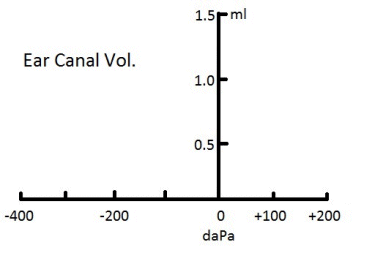 Both the pressure and
compliance are recorded and plotted on a graph against each other. The
most sound is admitted into the middle ear when the air pressure is
identical on both sides of the eardrum (normal atmospheric pressure and
middle ear pressure) and this is usually 0 daPa. Additionally ear canal
volume
Both the pressure and
compliance are recorded and plotted on a graph against each other. The
most sound is admitted into the middle ear when the air pressure is
identical on both sides of the eardrum (normal atmospheric pressure and
middle ear pressure) and this is usually 0 daPa. Additionally ear canal
volume
The pressure at which maximum compliance is achieved provides
information about the middle ear function and how this may be related
to hearing loss. It can be useful in determining differential diagnosis
between sensorineural and conductive hearing losses.
Traditionally tympanograms were classified into different Types
(Jerger, J. (1970). Clinical experience with impedance audiometry.
Archives of Otolaryngology, 92, 311–324.). These were simply A, B and C
with a number of sub types, Ad & As, C1 & C2. However more
recent guidelines (http://www.thebsa.org.uk/images/stories/BSA_RP_Tymp_Final_21Aug13_Final.pdf)
recommend including the shape of the curve and the various measurements
obtained.
Tympanometric Shape:
The trace should have
one sharp peak and it may be rounded or wide. It is possible to have
two peaks where there is scarring on the eardrum and the test should be
repeated to exclude artefacts. The shape of the tympanogram may be
described as; normal, rounded, flat, and wide or 'W' shaped.
Middle Ear Pressure:
This is the tympanic
peak pressure (highest point) on the horizontal axis. Normal is
considered to be 0daPa but for adults -50 to +50 daPa is within normal
limits and pressures down to -100daPa may have little clinical
significance. Children's values range from +50 to -200daPa.
Compliance:
This is the value on
the vertical axis and is measured in cubed centimetres or millilitres
(& mmho if 226Hz probe tone is used). It is deemed the peak value
once it has been corrected for the ear canal contribution (normally
done by default). Normal compliance range is 0.3 to 1.6cm3 but
children's lower limit can be 0.2cm3 if under 6 years old.
Ear Canal Volume:
This contributes to
compliance when a 226Hz probe tone is used and is compensated for
accordingly. Normal ear canal volume (ECV) for adults is 0.6 to 1.5cm3
and for children it is 0.4 to 1.0cm3. Should the probe tip be occluded
(due to debris, etc) or pressed against the wall of the canal a very
small ECV will be obtained and if there is an ear drum perforation then
the ECV will be abnormally large. Both of these instances will cause a
flat 'trace'.
Types of Tympanogram Results
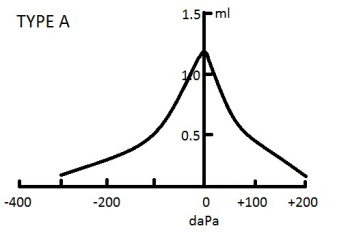 Normal
(Type A) Tympanogram
Normal
(Type A) Tympanogram
Probable normal
middle ear function.
Shape: normal
Middle Ear Pressure: Normal, +/-100daPa for adults (+50 to -200daPa for
children)
Compliance: Normal, 0.3 to 1.6cm3 for adults (0.2 to 1.6cm3 for
children)
ECV: Normal, 0.6 to 1.5cm3 for adults (0.4 to 1.0cm3 for children)
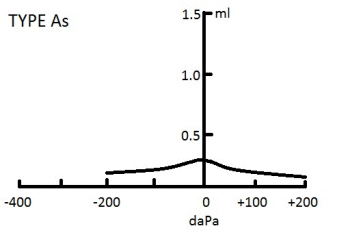 Type As (Shallow) Tympanogram
Type As (Shallow) Tympanogram
Probably a less
compliant middle ear system. Usually these types of tympanograms have a
history of middle ear problems ranging from repeated childhood otitis
media, otosclerosis or tympanosclerosis.
Shape: normal but flattened
Middle Ear Pressure: Normal, +/-100daPa for adults (+50 to -200daPa for
children)
Compliance: Reduced, less than 0.3cm3
ECV: Normal, 0.6 to 1.5cm3 for adults (0.4 to 1.0cm3 for children)
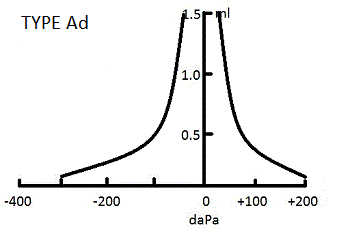 Type Ad (Deep)
Tympanogram
Type Ad (Deep)
Tympanogram
A highly compliant
system
These can be seen in patients that had multiple perforations
previously, or frequent insertion of grommets. It may also indicate an
ossicular chain disruption.
Shape: normal but exaggerated
Middle Ear Pressure: Normal, +/-100daPa for adults (+50 to -200daPa for
children)
Compliance: Increased, more than 1.4cm3 (ASHA, 1990)
ECV: Normal, 0.6 to 1.5cm3 for adults (0.4 to 1.0cm3 for children)
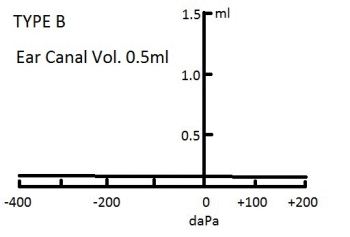 Flat (Type B - Low) Tympanogram
Flat (Type B - Low) Tympanogram
Suggestive of middle
ear dysfunction.
Patients with Type B tympanograms can have otitis media. This is
particularly common when a patient has a cold and is also prevalent in
children. Hearing loss may be present in cases of middle ear effusion.
Shape: Flat
Middle Ear Pressure: None detectable
Compliance: None detectable
ECV: Normal, 0.6 to 1.5cm3 for adults (0.4 to 1.0cm3 for children)
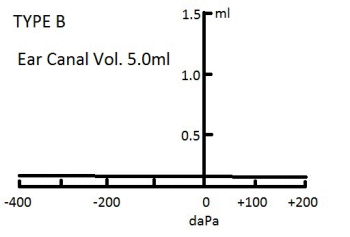 Flat (Type B- High) Tympanogram
Flat (Type B- High) Tympanogram
Indicative of a
grommet or perforation.
Perforations can cause a drop in low-pitched hearing and can
progressively get worse. The most common causes of perforation arise
from ear infections, trauma and extreme pressure changes i.e. diving
and flying.
There is no identifiable peak with an ear canal volume greater than 1.5
cm3.
ENT referrals are recommended in almost all cases. It is important to
note that an ear with a perforation is no longer waterproof and a
swimming plug may be necessary in these cases. The presence of a patent
grommet also often creates slightly elevated low-pitch thresholds.
Shape: Flat
Middle Ear Pressure: None detectable
Compliance: None detectable
ECV: Large, greater than 1.5cm3 for adults (<1.0cm3 for children)
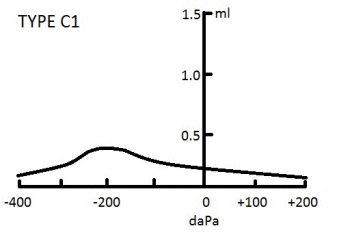
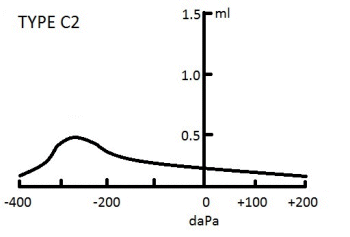 Negative Pressure (Type C)
Negative Pressure (Type C)
Suggestive of
Eustachian tube dysfunction.
These tympanograms usually occur after a patient has had a cold or is
about to get one. Patients with repeated Type C tympanograms can be at
risk of cholesteatomas. Type C tympanograms should be reviewed
regularly to see the progression (improvement, the same or worsens).
Type C tympanograms are subdivided into C1 or C2, this merely indicates
the severity of the negative pressure. C1 denotes pressure down to
-200daPa and C2 is lower.
Shape: normal
Middle Ear Pressure: Reduced, less than -100daPa for adults (less than
-200daPa for children)
Compliance: Normal, 0.3 to 1.6cm3 for adults (0.2 to 1.6cm3 for
children)
ECV: Normal, 0.6 to 1.5cm3 for adults (0.4 to 1.0cm3 for children)
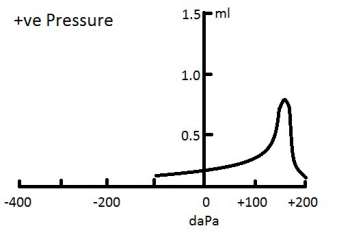 Positive Pressure
Positive Pressure
Suggestive of acute
middle ear infection
A positive pressure in the middle ear could be due to air forced into
the middle by sneezing or altitude change but can also be signs of an
acute middle ear infection. There is risk of the eardrum rupturing in
this type.
Middle Ear Pressure: Increased, more than +100daPa for adults (more
than +50daPa for children)
Compliance: Normal, 0.3 to 1.6cm3 for adults (0.2 to 1.6cm3 for
children)
ECV: Normal, 0.6 to 1.5cm3 for adults (0.4 to 1.0cm3 for children)

